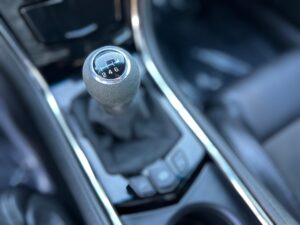Trading in your car is like ordering coffee at a fancy café: it’s simple on the surface, but if you don’t know what you’re doing, you could end up spending more than you planned.
As a top-rated car dealership that’s seen it all (and we do mean all), we’re here to help you navigate the world of car trade-ins. Whether you’re looking to upgrade to something snazzy, downsize, or just want a change, here’s how to trade in your car for maximum value.
1. Know Your Car’s Worth (Knowledge Is Power)
Before you even think about stepping foot onto a dealership lot, do your homework. We’re talking CarFax reports, Kelley Blue Book (KBB) valuations, and even a bit of light Googling.
- Start with KBB or Edmunds: These websites are like the online dating profiles of cars. They’ll give you an idea of your car’s worth based on its age, mileage, condition, and features.
- Check the Market: Look up cars similar to yours for sale in your area. If your 2015 Honda Civic with 100,000 miles is going for $12,000 in private sales, you have a ballpark.
- Get Multiple Quotes: Think of trade-in appraisals like second opinions at the doctor. You wouldn’t take one opinion as gospel, right? Visit a few dealerships or use online tools like Carvana or Vroom for free quotes.
Knowledge is your best weapon in the trade-in game. If you walk into a dealership armed with solid research, you’re already ahead of the game.
2. Clean Your Car’s Act (Literally)
No one likes a messy car, not even us. A clean car screams “well-maintained,” and that can add to its perceived value. Here’s what you can do:
- Wash It: A good ol’ car wash can work wonders. Make it sparkle like a contestant on a reality TV makeover show.
- Declutter: Get rid of that half-empty water bottle, rogue french fries, and the gym bag you haven’t opened since last January. Clean out the trunk too—no one wants to discover your emergency stash of questionable snacks.
- Detailing: If you’re really serious, consider a professional detailing service. Think of it like a spa day for your car. Believe us, a clean interior and exterior can help nudge up the value during appraisal.
3. Fix the Small Stuff (But Don’t Go Overboard)
Small repairs can make a big difference. Got a headlight out? Fix it. Minor scratches? Buff them out.
But don’t go spending thousands on major repairs unless you’re sure you’ll recoup that cost. A new transmission might not be worth the investment if the dealership isn’t willing to account for it in the trade-in value.
Pro Tip: If your car has serious issues, be honest about it. We’ll find out anyway during our inspection (we’re kind of like detectives, but for cars).
4. Timing Is Everything
Did you know the time of year can affect your trade-in value? Here’s how:
- Tax Season: When people get their tax refunds, demand for used cars spikes. More demand = better trade-in offers.
- Seasonality: SUVs and trucks are in higher demand during winter, while convertibles and sports cars get more love in the spring and summer.
- Before a New Model Drops: If your car’s current model year is about to be replaced by the next one, trade it in before the new models hit the lot.
5. Gather Your Paperwork (Adulting 101)
Dealerships love organized customers. It makes our job easier and speeds up the process for you. Here’s what you’ll need:
- Title: If you own your car outright, bring the title. No title? No trade-in.
- Loan Information: If you still owe money, bring your loan details so we can sort it out.
- Maintenance Records: A well-maintained car is a valuable car. Show us the receipts!
- Spare Keys: Yes, we want those, too.
Having all your ducks (and documents) in a row signals to us that you’re serious and trustworthy.
6. Be Realistic About Your Car’s Condition
We know you love your car, but let’s face it: your 10-year-old minivan with a dented bumper and a funky smell isn’t going to fetch top dollar. Be honest with yourself about its condition.
- Excellent Condition: Almost like new, with no major repairs needed and low mileage.
- Good Condition: Minor wear and tear but no major issues.
- Fair Condition: Noticeable wear and maybe some minor repairs needed.
- Poor Condition: High mileage, major issues, or a history of accidents.
If you’re upfront about your car’s flaws, we’ll appreciate it and be more likely to offer a fair deal.
7. Negotiate Like a Pro
Here’s where things get fun (or nerve-wracking, depending on your personality). Negotiating your trade-in value is part of the process, so don’t be shy.
- Start High: Always ask for more than you’re willing to accept. It’s easier to negotiate down than up.
- Leverage Your Research: Remember all that homework you did? Use it to back up your case.
- Don’t Combine Deals: Keep the trade-in negotiation separate from the new car purchase. This helps you see the true value of each deal.
Pro Tip: Be polite but firm. We’re human, too, and we’re more likely to work with you if you’re reasonable.
8. Consider Selling Privately (But Know the Hassles)
If you’re not happy with the trade-in offers you’re getting, selling your car privately might be a better option. You’ll often get more money, but it’s not without its challenges:
- Time-Consuming: You’ll need to list your car, respond to inquiries, and deal with potential buyers.
- Safety Concerns: Meeting strangers for test drives can be risky.
- Haggling: Prepare for endless back-and-forth negotiations.
If you’re short on time or patience, a trade-in might still be the better choice.
9. Beware of Lowball Offers
Not all dealerships are created equal. If someone offers you a trade-in value that’s laughably low, don’t be afraid to walk away. Your car is worth what the market says it’s worth, and if you’ve done your research, you’ll know when you’re being undervalued.
Pro Tip: Always get multiple offers. Competition among dealerships can work in your favor.
10. Embrace the Process (And Don’t Take It Personally)
Trading in your car is a business transaction, plain and simple. It’s not a reflection of your car’s “personality” or how much you loved it. If we offer less than you expected, it’s not because we don’t like your car. We have to consider market demand, reconditioning costs, and how quickly we can sell it.
That said, we want you to leave happy. A good deal is one where both parties walk away feeling like winners.
Final Thoughts
Trading in your car doesn’t have to be a stressful ordeal. With a little preparation, a dash of realism, and a pinch of negotiation savvy, you can walk away with a fair deal (and maybe even a shiny new set of wheels).
At the end of the day, we’re here to help. So, whether you’re looking at how to trade in your beloved first car or parting ways with the minivan that survived three kids and a dog, know that we’ve got your back. And who knows? Maybe we’ll see you driving away in something that makes you grin from ear to ear.
To find out what your car is worth, fill out our online trade appraisal form and we’ll give you a realistic and honest estimate. Best of luck!




